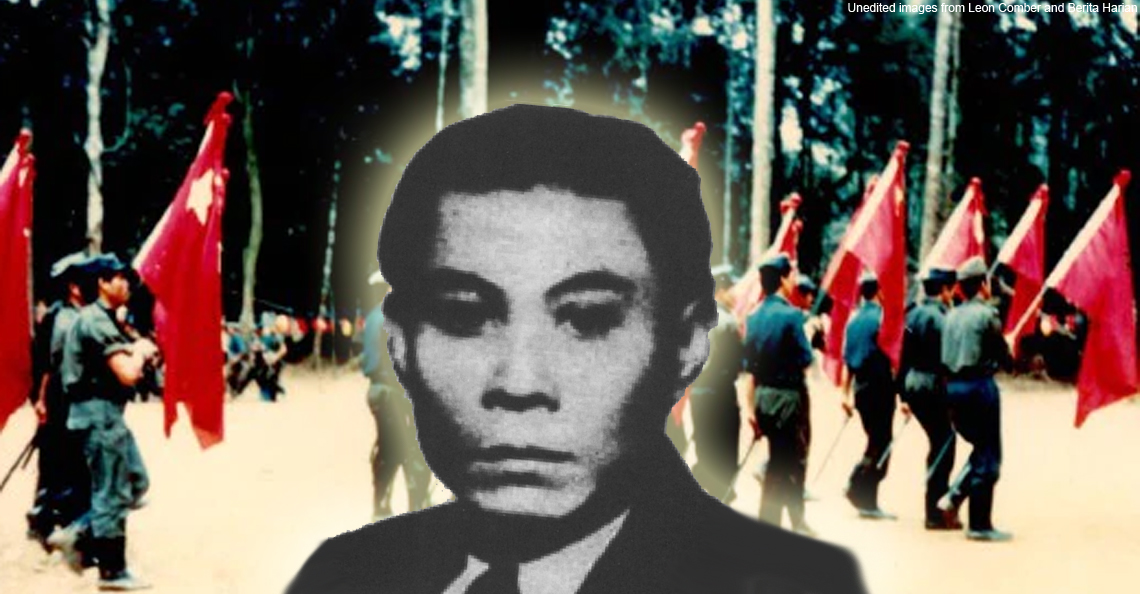Was this 100 year-old man the Malay warrior Mat Kilau? The Pahang government says yes
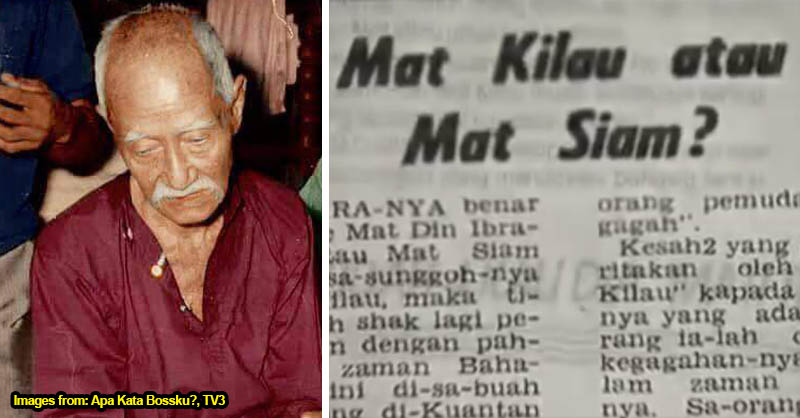
- 183Shares
- Facebook126
- Twitter8
- LinkedIn11
- Email9
- WhatsApp29
Translated from original BM article by our sister site Soscili.
After some delays in production, Syamsul Yusof’s ‘Mat Kilau’ was finally released in theaters recently to a tremendous reception, grossing RM12.2 million in 4 days (it cost RM4 million to make).

While we’ll now be able to watch the heroics of anti-British freedom fighter Mat Kilau on the silver screen, not many know about the real person himself. Incidentally, there’s actually some controversy surrounding him, particularly after the appearance of a mysterious man claiming to be Mat Kilau in 1969. But despite authorities verifying him as Mat Kilau, historians still have doubts over this man’s identity.
So we thought we’d tell the story of Mat Kilau, as well as go into why these doubts exist.
Seen as a traitor by the British, Mat Kilau’s village was burnt to the ground

Malaysian history, for the most part, is intertwined with the struggle of local resistance against colonizers. Mat Kilau bin Imam Rasu was one such member of the resistance during the turn of the 20th century. Born in Kampung Kedondong, Pulau Tawar, Jerantut, Pahang, his name was well-known among Pahangites, as he was the son of famed Pahang warrior Imam Rasu, or Tok Gajah. Even as a youth, he was charismatic, and inspired many followers.
Around the 1890s, resistance against the British increased as the British began to take control of taxation and elect a British Resident; both of which undermined the powers of Pahang’s Sultan and nobles such as Datuk Bahaman and Mat Kilau’s father, Tok Gajah. However, the Sultan valued ties with the British, and refused to oppose them.
And so, Mat Kilau began his anti-British struggle alongside the nobles, sabotaging the British by cutting their telegraph lines, among other things. The British actually tried to convince Mat Kilau to switch sides, but to no avail. Because of this, he was labeled a traitor by the Brits, and they began hunting him down. Their brutality culminated in their burning of Mat Kilau’s village, which forced Mat Kilau to flee, moving from place to place and never settling.
In October 1895, Singaporean newspapers The Straits Times and The Singapore Free Press reported the death of Mat Kilau.
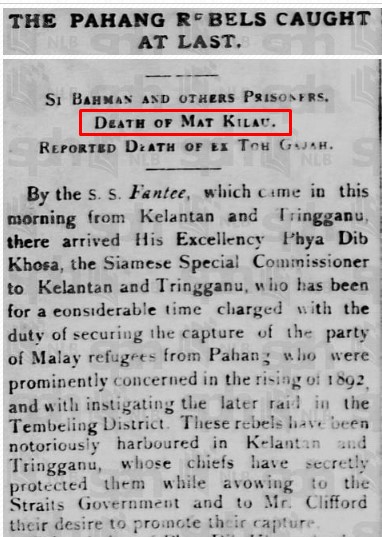
Reportedly, Mat Kilau received injuries to his head and face, and died whilst en route to Kota Bharu. And so ended the story of Mat Kilau.
Or so they thought…
The nation was shocked when Mat Kilau ‘came back from the dead’ in 1969
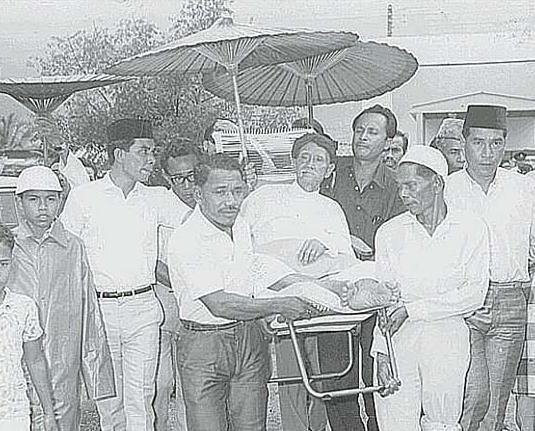
Around the late 1960s, news emerged of an old silat teacher who was over a 100 years old from Gambang, Kuantan, Pahang. Known as Mohamad bin Ibrahim aka Mat Siam, the man’s technique attracted Mat Kilau’s son-in-law, who saw that the old man’s characteristics were similar to his father-in-law, who had supposedly been dead for over 70 years.
This news reached the ears of Mat Kilau’s grandnephew, Zainuddin Mat Ali, who then met up with the man several times. From their conversations, Zainuddin was convinced that Mat Siam was none other than the long-lost Mat Kilau, and convinced him to return with him to his hometown in Pulau Tawar.
It was then decided that Mat Siam would reveal his true identity from Pulau Tawar, so as to avoid attention from the masses. So, on the 26th of December 1969, following the Friday prayer at the mosque, Mat Siam publicly announced that he was indeed the legendary war hero, Mat Kilau.
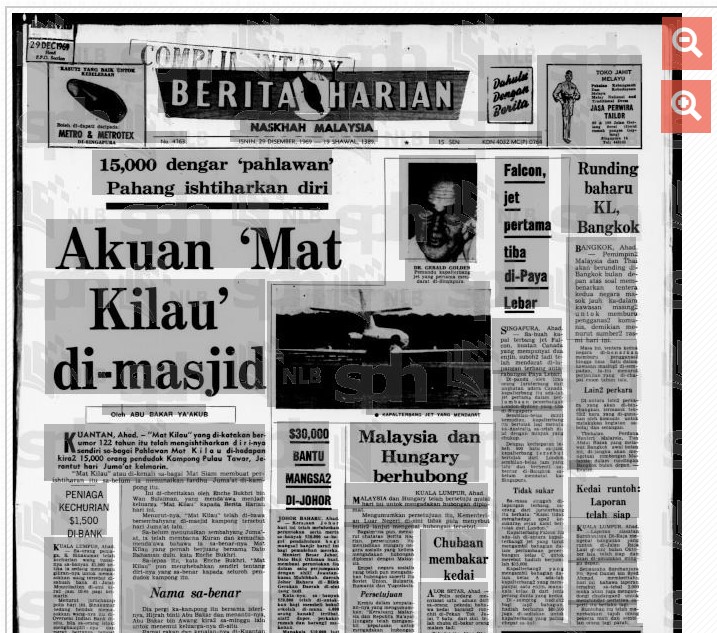
Following the claim, Pahang’s government formed the Committee To Investigate The Appearance of Mat Kilau (that’s legit what it was called), on the 8th of January 1970. They found that this alleged Mat Kilau had been living by many pseudonyms, and was a nomad who moved between Kelantan, Terengganu, and Pahang. His IC listed his name as Muhammad bin Ibrahim.
To determine his true identity, they called on some of his comrades from the time, namely, Mat Kelantan (around 90 years old), Raja Tan Kechik, and Mek Munah (97 years old). On the 6th of August 1970, the committee finally declared that Mat Siam was the famed Pahang warrior Mat Kilau. And yet…
Malaysia’s top historian was not convinced that Mat Siam is Mat Kilau

Interestingly, famed late Malaysian historian Professor Emeritus Tan Sri Khoo Kay Kim claims that crucial errors were committed following the revelation of Mat Kilau—one of which, was that the authorities had failed to isolate him for further study, and many were allowed to interview him before a proper investigation could be conducted. The reason this is bad is because if Mat Kilau was in fact an imposter, improper methods of interviewing could provide him with information to further help his facade.
Also, while the alleged Mat Kilau was able to identify his father Tok Gajah’s face from a photograph of Tok Gajah and Datuk Bahaman, Tan Sri Khoo claims that this in itself was not enough to form a conclusion:
“… this cannot be seen as concrete evidence, because Mat Kilau was not the only person to have ever seen Tok Gajah and Tok Bahaman. I am not (definitively) saying that this person was not Mat Kilau. But there is a huge difference between how academics and how regular people work.” – Professor Emeritus Tan Sri Khoo Kay Kim, in an excerpt from a TV3 documentary (translated from BM by Cilisos)

There were other factors that seemed to go against Mat Siam’s claim, especially the fact that Mek Munah was only a teenager when she met Mat Kilau, so it would have been impossible for her to identify him when she was well into her 90s.
But the biggest red flag for Tan Sri Khoo was Mat Siam’s claim that the Sultan of Kelantan at the time, Sultan Muhammad Mulut Merah, had personally aided his ‘disappearance’ by replacing his ‘body’ with the bark of a banana tree:
“… the Sultan, who was a renowned ruler, had passed away in 1886. The question is: how could Mat Siam have made such a huge error if he was in fact Mat Kilau?” – Professor Emeritus Tan Sri Khoo Kay Kim in Berita Harian, 29th March 1970 (translated from BM by Cilisos)
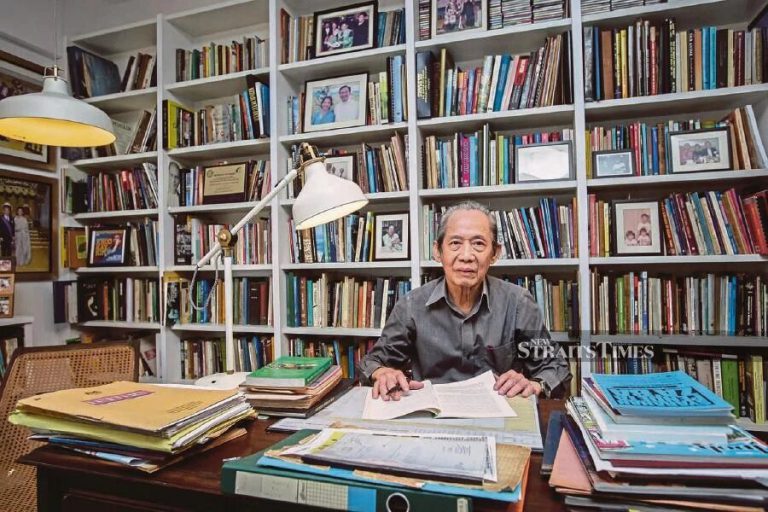
It was also said that Mat Kilau had lived close to his cousin Nobah Khatib Bahrin in Kampung Ayer Hitam, Pekan, from 1928-1932. However, Mat Kilau’s own nephew Haji Muhammad Abdullah reveals the two never met during this time, as she believed he had been killed in Kelantan:
“She was found weeping in a sorry state. It was said that Mat Kilau had fallen in Kelantan.” – Haji Muhammad Abdullah, 29th March 1970 (translated from BM by Cilisos
With that being said, Mat Siam was certainly convincing enough for many, as 70% of the special committee believed that Mat Siam was Mat Kilau. Was he really? Going by Tan Sri Khoo’s words, we’ll probably never know for sure.
Regardless, the real Mat Kilau was a major thorn in the side of the British
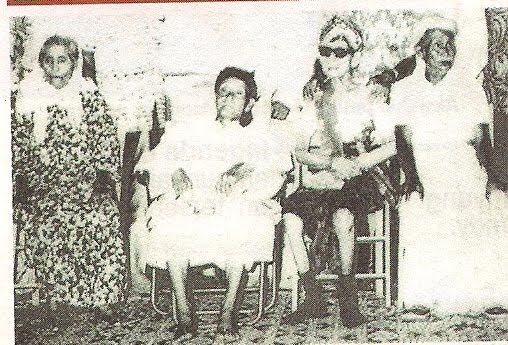
Whether or not Mat Siam was actually Mat Kilau, the fact remains that the real-life Mat Kilau was such a problem for the British that they had to spend a huge sum of money to employ Sikh reinforcements from overseas to help in their hunt for him. In fact, there are over 200 files on Mat Kilau’s anti-colonial struggle contained within the National Archives.
In any case, 10 days after Mat Siam’s declaration, he passed away at the ripe old age of 106. His body was laid to rest at Pulau Tawar, in a location now known as Makam Pahlawan Mat Kilau. Although it was never confirmed if Mat Siam was indeed Mat Kilau, it’s undeniable that the real Mat Kilau gave his all in the struggle for independence.
- 183Shares
- Facebook126
- Twitter8
- LinkedIn11
- Email9
- WhatsApp29



